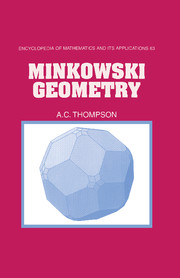Book contents
- Frontmatter
- Contents
- Preface
- Acknowledgements
- 0 The algebraic properties of linear spaces and convex sets
- 1 Norms and norm topologies
- 2 Convex bodies
- 3 Comparisons and contrasts with Euclidean space
- 4 Two-dimensional Minkowski spaces
- 5 The concept of area and content
- 6 Special properties of the Holmes–Thompson definition
- 7 Special properties of the Busemann definition
- 8 Trigonometry
- 9 Various numerical parameters
- 10 Fifty problems
- References
- Notation index
- Author index
- Subject index
1 - Norms and norm topologies
Published online by Cambridge University Press: 05 May 2013
- Frontmatter
- Contents
- Preface
- Acknowledgements
- 0 The algebraic properties of linear spaces and convex sets
- 1 Norms and norm topologies
- 2 Convex bodies
- 3 Comparisons and contrasts with Euclidean space
- 4 Two-dimensional Minkowski spaces
- 5 The concept of area and content
- 6 Special properties of the Holmes–Thompson definition
- 7 Special properties of the Busemann definition
- 8 Trigonometry
- 9 Various numerical parameters
- 10 Fifty problems
- References
- Notation index
- Author index
- Subject index
Summary
Minkowski geometry is the study of the interplay between two structures. The first is a finite dimensional, real linear structure and the second is a metric structure derived from a norm. The preceding chapter was concerned with the linear structure. However, before we look at the detailed metric properties derived from a specific norm, we turn to the more general topological properties induced by a norm. The essential fact is that there is only one Hausdorff linear topology with which a finite dimensional space can be endowed. This implies that between any two d-dimensional Minkowski spaces there is a linear homeomorphism or, more briefly, an isomorphism. Any property of the one space which depends only on the topology and the linear structure carries over to the other via the isomorphism. Stated more succinctly, the isomorphic theory of Minkowski spaces is rather uninteresting; the dimension is the only isomorphic invariant and all Minkowski spaces are completely classified up to isomorphism by this invariant. On the other hand, as we shall see, the isometric classification is too complicated. There is a vast array of non-isometric Minkowski spaces, even in two dimensions. Perhaps this is why Minkowski spaces have received less attention than they deserve – on the one hand, they are too simple and, on the other, too complicated.
The chapter has four sections and, for the most part, the ideas discussed are the familiar ones presented in a course on metric space topology or at the beginning of a course on functional analysis. The exception is the material in the final section.
- Type
- Chapter
- Information
- Minkowski Geometry , pp. 13 - 44Publisher: Cambridge University PressPrint publication year: 1996

